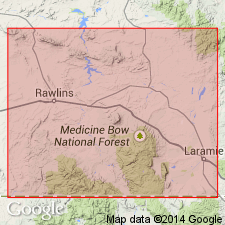
- Usage in publication:
-
- O'Brien Spring Member*
- Modifications:
-
- Named
- Dominant lithology:
-
- Sandstone
- AAPG geologic province:
-
- Green River basin
Summary:
Pg. 12-18. Name proposed for member of the Haystack Mountains Formation (new) of Mesaverde Group (rank raised). At type section, composed of thin-bedded, pale-yellowish-gray, brown-weathering, fine-grained sandstone with sandstone concretions and abundant fossil burrows (OPHIOMORPHA), 220 feet (67 m) thick; is cliff-forming. Gradationally overlies lower unnamed shale member and conformably underlies middle unnamed shale member of the Haystack Mountains Formation. Is a shallow-water marine deposit. Age is Late Cretaceous (early Campanian). Table 1 shows correlation with other units of the same age in south-central Wyoming.
Type section: measured 9.6 km north of town of Sinclair, southern Haystack Mountains, in NE/4 NE/4 sec. 22, NE/4 sec. 23, and SE/4 SE/4 sec. 14, T. 22 N., R. 86 W., Carbon Co., south-central WY (Greater Green River basin). Named from exposures at O'Brien Spring, in SW/4 sec. 9, T. 24 N., R. 86 W., Seminole Dam SW 7.5-min quadrangle.
Source: US geologic names lexicon (USGS Bull. 1520, p. 225); GNU records (USGS DDS-6; Denver GNULEX).
For more information, please contact Nancy Stamm, Geologic Names Committee Secretary.
Asterisk (*) indicates published by U.S. Geological Survey authors.
"No current usage" (†) implies that a name has been abandoned or has fallen into disuse. Former usage and, if known, replacement name given in parentheses ( ).
Slash (/) indicates name conflicts with nomenclatural guidelines (CSN, 1933; ACSN, 1961, 1970; NACSN, 1983, 2005, 2021). May be explained within brackets ([ ]).

